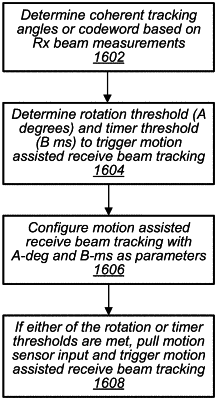| CPC H04B 7/088 (2013.01) [G01S 19/26 (2013.01); H04B 7/0617 (2013.01); H04B 7/0695 (2013.01); H04B 17/318 (2015.01); H04L 5/005 (2013.01); H04W 16/28 (2013.01)] | 20 Claims |

|
1. A method, comprising:
by a wireless device:
establishing a cellular link with a cellular base station;
selecting a receive beam configuration for the cellular link including a selected receive antenna orientation of the wireless device, said selecting comprising performing receive antenna orientation selection using reference signals from the cellular base station without using motion sensing information;
receiving a downlink data beam using the selected receive antenna orientation;
determining one or more triggers for selecting a possible modification to the selected receive antenna orientation based at least in part on motion sensing information generated by the wireless device and based at least in part on determining that the selected receive antenna orientation selection does not meet one or more receive antenna orientation selection conditions;
detecting a trigger for selecting a possible modification to the receive antenna orientation;
selecting the possible modification to the receive antenna orientation based at least in part on an estimated rotation of the wireless device relative to a previous position of the wireless device, wherein selecting the possible modification to the receive antenna orientation is performed based at least in part on detecting the trigger for selecting the possible modification to the receive antenna orientation;
determining whether the possible modification to the receive antenna orientation improves downlink data beam reception; and
determining whether to modify the receive antenna orientation for the cellular link in accordance with the possible modification to the receive antenna orientation based at least in part on whether the possible modification to the receive antenna orientation improves downlink data beam reception.
|